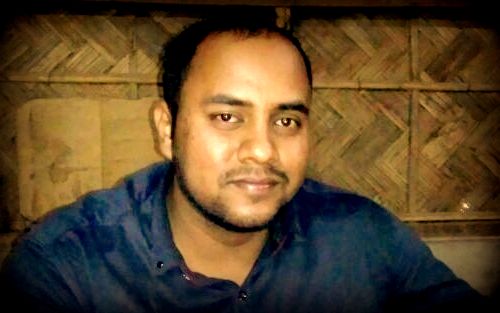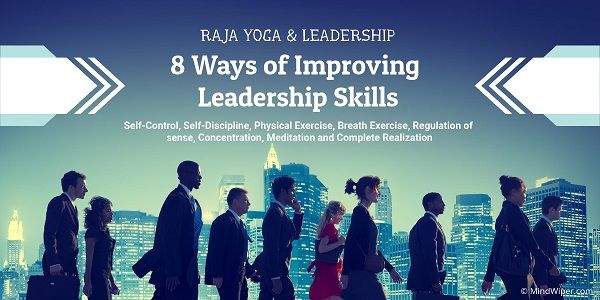Raja Yoga is one of the best spiritual practices of Hinduism. Raja means chief and Raja Yoga is considered to be the best of all Yoga. Most of the people think that yoga is a physical process. But, you should know that yoga is a cognitive process and the physical processes are called Asana in the Sanskrit language.
You may be curious to know, how spirituality and leadership are related. So, first of all, you should have a concrete idea about spirituality.
Spirituality is not about religion; spirituality is about finding the true nature of being a human. In modern terminology, it is the effective utilization of the cognitive skills.
Intelligent capabilities differentiate humans from animals. For this reason, Hinduism has four distinct paths to utilize our intelligence and identifying the true nature of being a human. And these paths are called spiritual practices.
Someone may say, spiritual practices are about realizing the God. However, the reality is we don’t know whether God exists or not. But, we know that cognitive development creates differences in intelligence among us, which is the reality. And the Hindus consider intelligent leaders who can impact on the people as a personal god.
In Hinduism, Bhakti Yoga signifies the personal god and the term religion is synonymous to the Bhakti Yoga. Karma Yoga and Jnana Yoga are the other spiritual practices in Hinduism, and these Yogas signify the work or ethics and intelligence respectively.
The goal of the Raja yoga is Samadhi or complete realization, and it is about understanding the true essence of being a human. Nobody can become a good leader, without realizing the true nature of the human beings.
Without further delay, let’s understand how Raja Yoga and Leadership are related.
How Raja Yoga is Related to Leadership
I will start with the best leadership quote from John. C Maxwell; he said,
“A leader is one who knows the way, goes the way and shows the way.”
What a leader does, millions follow. There is no doubt that a leader has to be the best; leaders should have the intelligence for realizing the nature, knowledge, wisdom of being a human.
A leader needs self-control, self-discipline, critical thinking, effective communication, hypothetical thinking and all these can enhance developing a vision and personal power of a leader.
Raja Yoga guides to strengthen the personal power and the personal power improves leadership skills. You should also know that personal power is the reflection of cognitive development. Also, cognitive development is compelling when we develop deductive thinking, hypothetical thinking and the capability of thinking about thinking.
All these cognitive skills develop in the “Formal Operational Stage” of Piaget’s theory of cognitive development. However, most of the people fail to reach this stage of cognitive development. But, the question is, can development of “Formal Operational Stage” really makes a leader?
Absolutely no, development of this stage can make scholars, innovators or any other kind intellectuals. However, mental diets and ineffective practices of these skills can hamper developing the intelligence of a human.
Raja Yoga has classified eight steps. And the last stage Samadhi or complete realization is about effective utilization of the skills developed in the “Formal Operational Stage.”
Practicing the Raja Yoga in a monastic life can’t make anyone a leader. Most of the Raja Yoga practitioners focus on the physical exercises of the Raja Yoga or in the third step called as Asana. And very few people can reach the final state “Samadhi or complete realization” due to ineffective development of the “Formal Operational Stage” of cognitive development.
Swami Vivekananda was the first one to equate Raja Yoga with the Yoga Sutras of Patanjali. The cognitive theory had not developed at that time. However, here is one of his best quotes for complete realization.
“Talk to yourself once in a day, otherwise you may miss meeting an excellent person in this world.”
The complete realization involves the development of automatic deductive thinking, hypothetical thinking and thinking about thinking. And all these skills are about talking to your inner self. Think about a hypothetical question and check the conversation between you and yourself, you will realize how excellent you are.
Let’s understand the eight steps of Raja Yoga and leadership lessons from these steps.
Leadership lessons from Raja Yoga
The eight steps of Raja Yoga provide a systematic approach to attain the inner peace, clarity, self-control, and realization.
1. Yama – Self Control
Self-control means controlling the mind, thoughts or emotion and regulating the sense.
If you don’t have control over mind, awaiting thoughts or external sensory inputs are ready to engage your mind and take control over it.
But, how can anyone control the mind?
You have to engage your mind; you can’t control it otherwise. The Human mind needs engagement. And when you don’t engage your mind, awaiting thoughts generated from your long-term memory or external sensory interrupts are always ready to distract the mind subconsciously.
Self-control consists of five principles; these are – non-violence, truthfulness, non-stealing, pure way of life and non-accumulation of possessions. These are essential qualities of a good leader, Mahatma Gandhi was a follower of these five principles, and in fact, he had affirmed that Swami Vivekananda influenced him.
Self-control also means the control over thoughts, emotions and sensory inputs. Anxiety, depress or stress are some example of the unwanted thoughts. When thoughts attack you, you have to engage the mind in something else; otherwise unwanted thoughts are always ready to hijack the intelligence.
You can realize the self-control when you understand how the human mind works; you should read the human mind model.
2. Niyama – Self-Discipline
Self-discipline means keeping practices, identity, vision or goal consistent throughout the lifetime.
If you want the people to follow disciplines, first of all, you have to be self-disciplined. When a leader lost his vision or identify, you can’t expect people to follow that leader any longer.
Self-discipline is a practice. Self-discipline starts with the self. It comes from inside, that is from your perception & behavior. And it never comes from outside or through motivation or sensory stimulation. Even if it comes from outside, it is temporary.
3. Asana – Physical exercise
Physical exercise increases blood flow to the hippocampus. The hippocampus is associated mainly with memory, particularly the long-term memory and it regulates our emotions.
One of the studies found that aerobic fitness reduces brain tissue loss in aging humans. Being a leader, you need learning skills, problem-solving skills, and decision-making skills and for all these, you must have good retention or memory.
You can practice Surya Namaskar asana; this asana takes only a few minutes, this asana helps to improve blood circulation inside the body and keep you energetic throughout the day.
4. Pranayama – Breath Exercise
Breath exercise helps to improve attention, focus, and blood circulation.
When you master the art of breath control, you can control anxiety, depression by distracting the mind by taking a deep breath while these unwanted thoughts attack you.
You can read more about the importance of breath in the human mind model.
Breath control exercise is one of the primary functions of meditation. You can also try a nice app Headspace for mindfulness and meditation.
5. Pratyahara – Regulation of senses from external objects
It is about regulating the senses, more specifically you have to be in the engaged state of mind.
Public speaking or presentation needs focus and attention. When a leader distracts his mind through external sensory inputs, you know how the speech would be. This physical nature is bound to change. If you want to be a good leader, look inside, not outside.
Also, a leader should not discriminate between genders. We have to realize that nature created two genders among all living creature only for the sack of reproduction. For that purpose, we all have the difference in few hormones and two external organs. And we call one as male and other as female.
However, nature has provided human thinking capability for utilizing the intelligence. Most of the people lost the mind due to thinking of these gender differences, even children or your pets don’t think or discriminate between male or female all the time.
6. Dharana – Concentration
A leader needs concentration while speaking, learning, creating a vision and utilizing the intellect. Leaders need to practice active listening, conscious speaking, and mindfulness.
We generally lose concentration when internal thoughts or external sensory inputs distract the mind. In most of the cases, we practice distraction due to the unwanted thoughts or the unstructured pattern of thinking.
Our concentration capability is a practice. But the question is how to practice concentration.
When your attention wanders away, you have to bring it back. The more you practice concentration, it becomes a habit. And then the bringing back from distracted state runs on autopilot.
7. Dhyana – Meditation
Meditation is the sustained attention on a particular object for a long time.
Active listening, conscious speaking and public speaking, all these are the meditation skills of leadership. Concentration becomes meditation when our mind is no longer distracted by intrinsic thoughts.
You can meditate anywhere and anytime. You have to be conscious of the moment, and that is the meditation for a leader. As we practice concentration more, concentration becomes meditation.
8. Samadhi – Complete Realization
This is the final stage of Raja Yoga, most of the people can’t reach this stage. As I mentioned earlier, effective development of deductive thinking, hypothetical thinking, and metacognition in the “Formal Operational Stage” determines the capability of complete realization.
This state requires the ability of visualization, concrete analysis, thinking about thinking and effective utilization of the power of subconscious mind or the long-term memory. In this state, critical thinking becomes a habit, and all the critical thinking runs as an automatic program in our mind.
Humans mind can easily remember & recall extreme emotions or relational information. However, you can remember through repeated actions. Also, you should know that our long-term memory stores everything information in the form of images, sounds or sensation.
When visualization, automatic critical thinking, effective utilization of subconscious mind, and automatic deductive thinking or metacognition all work together in meditation or long-term focus, we can say it as Samadhi or complete realization.
Conclusion
As a leader, you should always remember that our words or actions are the reflections of our mental diet. And where our attention goes, our energy flows.
Here I am completing this post with a beautiful quote from Nikola Tesla,
“If you want to find the secrets of the universe, think in terms of energy, frequency and vibration.”
In the case of human psychology, energy is our thoughts generated due to mental intakes; vibration is the rate of neurological signal and frequency is the rhythm of our breath. Forget about neurological signal, you can start regulating your mental intakes and rhythm of the breath from today.

Ashim, the Founder of MindWiper, loves to learn, share, and educate various dimensions of life skills development. After graduating with an engineering degree, he worked with major ICT industries in India and finally he followed his dream to integrate technology for Cognitive Skills & Life Skills Development.

